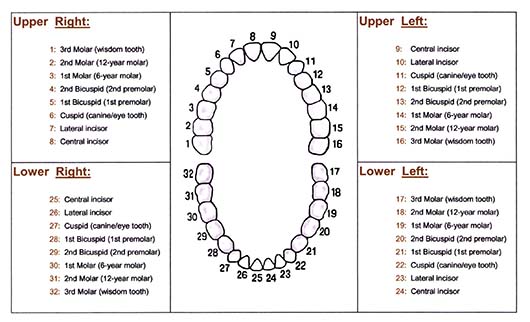
.gif)
Definitions Of General Dental Terms
A. Names Of Individual Teeth
B. Parts Of A Tooth And Your Mouth
C. Other Dental Terms
http://www.bracesinfo.com/glossary.html
A. Names And Numbers Of Individual Teeth
1. International Tooth Chart Numbering
2. Names Of Individual Teeth
click for detalied image
Central Incisor: The two upper and two lower teeth in the very center of your mouth. |
Lateral Incisor: The teeth just adjacent to the centrals. |
Cuspid: The pointy teeth just behind the laterals. These teeth have one cuspal (or point). Cuspids are also called canines. They have the longest roots of all dentition. |
First Bicuspid: The teeth just behind the cuspids. These teeth have two cuspals (or points) |
Second Bicuspid: The teeth just behind the first bicuspids. These teeth also have two cuspals (or points). |
First Molar: The teeth just behind the second bicuspids. These teeth have a level surface with four cuspals. |
Second Molar The teeth just behind the first molars. These teeth also have a level surface with four cuspals. |
Third Molar: The teeth just behind the second molars. These teeth also have a level surface with four cuspals. Third molars are also called wisdom teeth. |
6 year molar: Another name for your first molar |
12 year molar: Another name for your second molar |
Anterior Teeth: Your centrals, laterals, and cuspids. These are the teeth in the front of your mouth |
Posterior Teeth: Your bicuspids and molars. These are the teeth in the back of your mouth. |
Deciduous Teeth: Your primary, or "baby teeth". Think of trees that lose their leaves or deciduous trees. |
Palmer Notation For Numbering Teeth: Palmer's notation is a widely used method to designate individual teeth. In Palmer's notation, your mouth is divided into four parts called quadrants, that is the upper left quadrant, the upper right quadrant, the lower left quadrant, and the lower right quadrant as illustrated in the figure on the right. Then each individual tooth in the quadrant is given a name. For example, the two upper and two lower teeth at the center of your mouth are called central's. One then combines the names of the Primary teeth: The first set of teeth which come in. Primary teeth are also called "baby teeth" or deciduous teeth. |
Secondary Teeth: Your permanent teeth, i.e. the second group of teeth to come in. |
Quadrants: The four parts of your mouth, that is the upper left, the upper right, the lower left, and the lower right. |
Numerical Notation For Teeth: The numerical notation for teeth is an alternate to Palmer's notation. In this notation, the centrals are designated as 1's, the laterals as 2's, the cuspids as 3's, the first bicuspids as 4's, the second bicuspid's as 5's, etc. |
Universal or International Numerical Notation For Teeth: The universal or international numerical notation is the most common numerical notation for teeth used by general dentists in the United States. In this notation, your upper right third molar is designated as tooth#1, and then you number each tooth sequentially moving right to left and down across your mouth. There are other dental specialists who number the teeth by quadrants. |
Dental Implant Glossary
http://www.enexus.com/dental-implant/glossindex.htm
